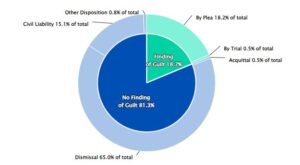
We recently added 2022 and 2023 Automated Criminal Infractions System (ACIS) court records data to our Measuring Justice Dashboard. We also just released a new Dashboard metric showing how North Carolina criminal charges get disposed. At the Lab, we support evidence-based approaches to criminal justice that promote public safety, a fair and effective system, and economic opportunity for all people. There is a lot in the new Dashboard metric that can be used to advance these goals.
To help unpack the Dashboard’s new Charge Disposition metric, let’s look at the big picture. From 2014−2023, nearly 15 million criminal charges were disposed in North Carolina. As shown in the figure below, less than one in five (18.7%, 2.8 million charges) resulted in a finding of guilt. Four of every five disposed charges (81.3%, over 12 million charges) were resolved with no finding of guilt.
For charges that resulted in a finding of guilt, those determinations overwhelmingly came from guilty pleas; less than 3% of the determinations that resulted in a finding of guilt came from a trial.
What about the more than 12 million charges that didn’t end in a determination of guilt—how were they resolved? As the figure below shows, the vast majority were dismissed. Resolution by civil liability (civil infraction) was the next largest disposition type for charges that didn’t result in a finding of guilt.
How criminal charges get resolved, all disposed charges (14,904,307), statewide, 2014-2023

The Dashboard allows you to dig deeper. For example, you can explore these data points by charge type (e.g., all felonies, violent felonies, all misdemeanors, traffic safety misdemeanors, etc.). Although the percentage of charges that result in a finding of guilt varies among these offense categories, there only is one offense category—impaired driving offenses—where the majority of charges result in a finding of guilt (61.6% for impaired driving offenses). For all other offense categories, only a minority of charges result in a finding of guilt. The offense category that has the lowest percentage of charges that result in a finding of guilt is traffic safety misdemeanors. This category of offenses includes things like speeding, reckless driving, and hit and run. For the more than 3 million traffic safety misdemeanors that were disposed across this time period, only 5.7% resulted in a finding of guilt. The most common disposition for traffic safety misdemeanors was a finding of civil liability (63.5% of all disposed traffic safety misdemeanor charges).
A Disposition Map visualization lets you compare this data point across counties; a Disposition Trend graph lets you see how it has changed over time; and a Race visualization breaks this data point down by racial and ethnic categories. Want to examine the data at the incident level? The Dashboard lets you do that as well. As with all metrics, the Dashboard provides data at the state level and for all 100 counties. Finally, the Dashboard’s Methodology section provides details on our underlying methodology.
To explore the new metric, go to the Dashboard and click on “Charge Disposition” in the menu on the left.
Creating and maintaining the Dashboard is a complex and large endeavor. Numerous people contributed to the new metric, including the Lab’s Senior Research Associate Jamie Vaske (Assistant Department Head, Director of Administration of Justice Program, Criminology and Criminal Justice Program, Western Carolina University); Lab Data Manager Ethan Rex; Lab Research Director Alex Cowell; and our data visualization team at North Carolina State University, including Justin Post, Director of Online Education, Department of Statistics and our graduate research assistant Rocco Matarazzo.
What’s next for the Dashboard?
First, we’re working on a defendant metric, providing key data points at the person level. Second, we’re working on adding Odyssey data to the Dashboard, hopefully before the end of the year.
Stay tuned for more information.
